雅思写作大作文思路 交通拥堵解决办法 traffic solutions.doc
雅思写作大作文思路 交通问题 traffic problems.doc

雅思写作大作文思路交通问题 traffic problems今天我们雅思写作大作文思路的文章来研究下交通问题。
对于大多数生活在城市中的同学而言,交通拥堵都是一个无法避免的问题。
同样的路程,平时可能只要20分钟,但堵车的时候1个小时都到不了。
只能无奈的坐在车里,看着前车的尾灯,一点点地向前挪。
那么究竟是什么原因导致交通拥堵呢?首先,私家车保有量的增长肯定要负一定的责任。
路上的车辆越来越多,但道路却没有变宽多少,行进起来自然就不是那么的顺畅。
其次,一些不遵守交通规则的车主也是拥堵的元凶之一。
他们乱停乱放,将本来就不宽敞的街道变得更加狭窄。
除此之外,还有哪些原因呢?小编搜集了一些相关的思路和素材,以供大家参考。
交通问题 traffic problemsTraffic congestion is caused by commuters travelling to work交通堵塞由通勤者开车上下班造成。
Most people live in the suburbs outside the city centre大多数人都生活在城市中心以外的郊区。
Commuters tend to travel at the same time of day通勤者倾向于在一天的同一时间出门。
They tend to travel alone他们总是独自上路。
Cars and road space are not used efficiently汽车和道路空间没有被有效的利用。
This causes traffic jams during the rush hour这导致高峰期的交通拥堵。
其他雅思写作交通运输类话题的思路解析。
解决道路拥堵的方案雅思作文
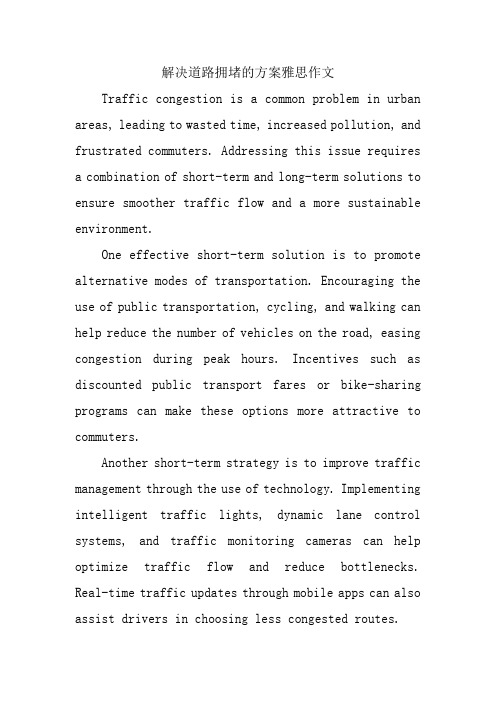
解决道路拥堵的方案雅思作文Traffic congestion is a common problem in urban areas, leading to wasted time, increased pollution, and frustrated commuters. Addressing this issue requires a combination of short-term and long-term solutions to ensure smoother traffic flow and a more sustainable environment.One effective short-term solution is to promote alternative modes of transportation. Encouraging the use of public transportation, cycling, and walking can help reduce the number of vehicles on the road, easing congestion during peak hours. Incentives such as discounted public transport fares or bike-sharing programs can make these options more attractive to commuters.Another short-term strategy is to improve traffic management through the use of technology. Implementing intelligent traffic lights, dynamic lane control systems, and traffic monitoring cameras can help optimize traffic flow and reduce bottlenecks. Real-time traffic updates through mobile apps can also assist drivers in choosing less congested routes.For long-term solutions, investing in infrastructure development is crucial. Building new roads, expanding public transportation networks, and creating dedicated lanes for buses and cyclists can significantly alleviate traffic congestion over time. City planners should also prioritize mixed-use development to reduce the need for long-distance commuting.Furthermore, promoting telecommuting and flexible work hours can reduce the number of vehicles on the road during peak times. Encouraging companies to adopt remote work policies can help spread out traffic demand throughout the day, easing congestion during rush hours.In conclusion, addressing traffic congestion requires a multifaceted approach that combines short-term measures like promoting alternative transportation modes and improving traffic management with long-term strategies such as investing in infrastructure and supporting flexible work arrangements. By implementing these solutions, cities can create a more efficient and sustainabletransportation system for the future.中文翻译:交通拥堵是城市地区常见的问题,导致时间浪费、污染增加以及通勤者感到沮丧。
关于如何解决繁忙交通的英语作文
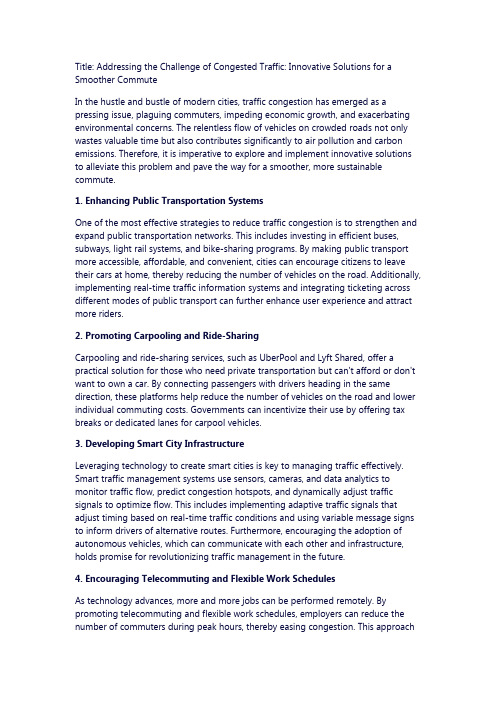
Title: Addressing the Challenge of Congested Traffic: Innovative Solutions for a Smoother CommuteIn the hustle and bustle of modern cities, traffic congestion has emerged as a pressing issue, plaguing commuters, impeding economic growth, and exacerbating environmental concerns. The relentless flow of vehicles on crowded roads not only wastes valuable time but also contributes significantly to air pollution and carbon emissions. Therefore, it is imperative to explore and implement innovative solutions to alleviate this problem and pave the way for a smoother, more sustainable commute.1. Enhancing Public Transportation SystemsOne of the most effective strategies to reduce traffic congestion is to strengthen and expand public transportation networks. This includes investing in efficient buses, subways, light rail systems, and bike-sharing programs. By making public transport more accessible, affordable, and convenient, cities can encourage citizens to leave their cars at home, thereby reducing the number of vehicles on the road. Additionally, implementing real-time traffic information systems and integrating ticketing across different modes of public transport can further enhance user experience and attract more riders.2. Promoting Carpooling and Ride-SharingCarpooling and ride-sharing services, such as UberPool and Lyft Shared, offer a practical solution for those who need private transportation but can't afford or don't want to own a car. By connecting passengers with drivers heading in the same direction, these platforms help reduce the number of vehicles on the road and lower individual commuting costs. Governments can incentivize their use by offering tax breaks or dedicated lanes for carpool vehicles.3. Developing Smart City InfrastructureLeveraging technology to create smart cities is key to managing traffic effectively. Smart traffic management systems use sensors, cameras, and data analytics to monitor traffic flow, predict congestion hotspots, and dynamically adjust traffic signals to optimize flow. This includes implementing adaptive traffic signals that adjust timing based on real-time traffic conditions and using variable message signs to inform drivers of alternative routes. Furthermore, encouraging the adoption of autonomous vehicles, which can communicate with each other and infrastructure, holds promise for revolutionizing traffic management in the future.4. Encouraging Telecommuting and Flexible Work SchedulesAs technology advances, more and more jobs can be performed remotely. By promoting telecommuting and flexible work schedules, employers can reduce the number of commuters during peak hours, thereby easing congestion. This approachbenefits both employees, who gain greater work-life balance, and employers, who can save on office space costs and increase productivity.5. Implementing Congestion PricingCongestion pricing involves charging drivers a fee to enter or travel throughhigh-traffic areas during peak hours. This economic incentive discourages unnecessary trips during peak times and encourages travelers to seek alternative modes of transportation or reschedule their commutes. Several cities around the world, including London and Singapore, have successfully implemented congestion pricing schemes, resulting in reduced traffic and improved air quality.6. Enhancing Non-Motorized TransportationImproving infrastructure for pedestrians and cyclists, such as building more bike lanes, pedestrian crossings, and safe routes to schools and public transit, can encourage people to leave their cars behind. This not only reduces traffic but also promotes healthier lifestyles and enhances the overall quality of life in urban areas.In conclusion, addressing the challenge of congested traffic requires a multifaceted approach that involves enhancing public transportation, promoting carpooling and ride-sharing, leveraging smart city technologies, encouraging telecommuting, implementing congestion pricing, and enhancing non-motorized transportation options. By adopting these innovative solutions, cities can work towards creating more livable, sustainable, and efficient urban environments for all.。
怎样解决交通拥挤问题英语作文

怎样解决交通拥挤问题英语作文怎样解决交通拥挤问题英语作文(精选7篇)在平时的'学习、工作或生活中,大家对作文都再熟悉不过了吧,写作文是培养人们的观察力、联想力、想象力、思考力和记忆力的重要手段。
那要怎么写好作文呢?以下是店铺帮大家整理的怎样解决交通拥挤问题英语作文,希望能够帮助到大家。
怎样解决交通拥挤问题英语作文篇1Nowadays, people in many big cities are complaining about the heavy traffic. ithas seriously influenced peoples daily life and economic development.To solve the problem, some pieces of advice are put forward.some people suggest that more streets and roads should be built. in this way,the traffic density can be redncedi hence speeding up the flow of buses and cars.But the new roads and streets will be filled with many cars and buses soon.Some people advise to limit the number of bikes and cars. this can decrease the traffic flow. But on the other haad, this will affect the consumption and make buses more crowded.In my opinion, the number of private cars should be put under control. And at the same time, buses should have their own special routes which cannot be used by other vehicles. Besides, underground train and city train should be developed quickly. 怎样解决交通拥挤问题英语作文篇2How horrible the traffic is! The picture depicts a scenario of a terrible traffic jam in the street. In fact, the traffic jam is so heavy that it is more of a parking lot than a crowded street. Anxious passengers cannot take buses because there are few buses. Instead, the street is filled with too many private cars.Exaggerated as it is, the phenomenon is not uncommonnowadays. With the number of private cars increasing②, traffic jams in metropolitans are bound to happen. Heavy transportation pressure in large cities may bring much inconvenience to people and exert negative impacts on the environment. On the one hand, when traffic jam happens, short distance in the past now seems to become terribly long, and drivers could do nothing but to wait. Therefore, a lot of precious time has been wasted on the road. On the other hand, exhausted gas emitted by cars has increased the burden of environment and caused carbon emission, which has diverted from the concept of living a low carbon life.Therefore, effective measures should be taken to alleviate the traffic jam. Firstly, taxes levied on the sales of private cars④ should be raised so as to restrict private car ownership rate. Secondly, public transportation such as buses and subways, which are low-carbon transportation means, should be encouraged and promoted so that we can have a smooth transportation.怎样解决交通拥挤问题英语作文篇3Traffic congestion has long been a problem of great concern and complaint in big cities. It has caused a lot of inconvenience to peoples life and work.The first cause is the great increase in the number of private cars. Cars take up more space but they carry fewer people. Some private car drivers, ignoring traffic regulations, drive only for the sake of their own convenience, blocking the way of other public transportation vehicles.The second cause is the slow and inefficient construction and improvement of the roads and streets. With a large population and numbers of automobiles increasing, some roads still remainunimproved, which will surely lead to problems. Let all of us act now to solve it.怎样解决交通拥挤问题英语作文篇4Nowadays, it’s hard to imagine how often you are a victim of traffic jam. As is shown in the picture, the road is crowded with hundreds of cars and buses, turning it into a huge parking lot.Why is the traffic so heavy these days? The reasons are complex. On the one hand, with the fast development of our economy and living standard the number of vehicles is rising sharply. Worse still, the road condition needs improving badly. Having been in use for many years, our traffic system is now out-of-date.When it comes to the solution to this problem, I have 3 suggestions. Above all, the government must take immediate measures to improve the road condition. New tunnels and overpasses must be built and old roads must be broadened. Besides,local government must improve the public transportation system. Finally, citizens must be encouraged to reduce driving and make more use of public transportation. Thus, not only can we relieve the pressure of transportation, but also we can contribute to environmental protection.In short, both the government and citizens must take on their own responsibilities. Only in this way can our transportation become more efficient.怎样解决交通拥挤问题英语作文篇5Traffic congestion has long been a problem of great concern and complaint in big cities. It has caused a lot of inconvenience to people's life and work. For example, people have to set off well in advance to get to work on time and come back very late when their work is over.There are many causes for this problem, but the following may be the most important ones.The first cause is the great increase in the number of private cars. Cars take up more space but they carry fewer people. Some private car drivers, ignoring traffic regulations, drive only for the sake of their own convenience, blocking the way of other public transportation vehicles. The second cause is the slow and inefficient construction and improvement of the roads and streets. With a large population and numbers of automobiles increasing, some roads still remain unimproved, which will surely lead to problems. The last cause is the insufficient management of the traffic system and the people's lack of awareness of traffic regulations. Many pedestrians cross the streets even when the traffic lights are against them, which is an obstacle to the flow of traffic.The problem of traffic congestion is an urgent one because it concerns the safety all of us. We will not resolve it if we only rely on the government. Let all of us act now to solve it.怎样解决交通拥挤问题英语作文篇6With the developing of the ecnomic,the traffic condictions in some big cities is becoming more and more worse,especially in the rush hour.People waste a lot of time in waiting the bus or in their way home. It's time the government take measures to improve the traffic conditiongs.In my view,first,government should broad the road to make more cars pass through.second,people should be encouraged to go by bus or bike instead of pravite cars,this will definitely reduce the air pollution as well.Third,people can go by subway in the rush hours.In a word ,I believe that we can improve our trafficcondictions if we try our best.怎样解决交通拥挤问题英语作文篇7As our economy grows at a fever pitch, and more and more people are moving into the major cities and industrial centers, traffic congestion becomes the order of the day.Traffic congestion not only creates headaches for commuters, but also reduces productivity by taking away valuable time from work. This sickness that plagues our cities must be at least put under control, if not cured.Some people advocate that more roads be built to accommodate the increase in traffic, others think that enlarging the capacity of public transit systems: buses, subway, trains…is the answer.Building more roads would mean a lot of land will be appropriated—not a very good prospect for economic, agricultural, and environmental reasons. On the other hand, forcing everyone to take public transit will bring inconvenience to those whose use of their cars is essential to their work. Putting more buses on the road may have the opposite effect as big buses tend to clog up narrow streets. Building an extensive subway system can be the ideal answer, but that is very expensive.Clearly, we cannot go for one single solution. A compromise must be struck between the different solutions. My personal view is that for cities that have plenty of unused land, more roads should be built. Having special lanes reserved for bicycles and motorcycles should encourage more people to use bicycles and motorcycles instead of cars. As a long-term solution, extensive subway, or surface monorail systems should be built for all the major cities.。
交通拥堵的原因和解决方法的英语作文
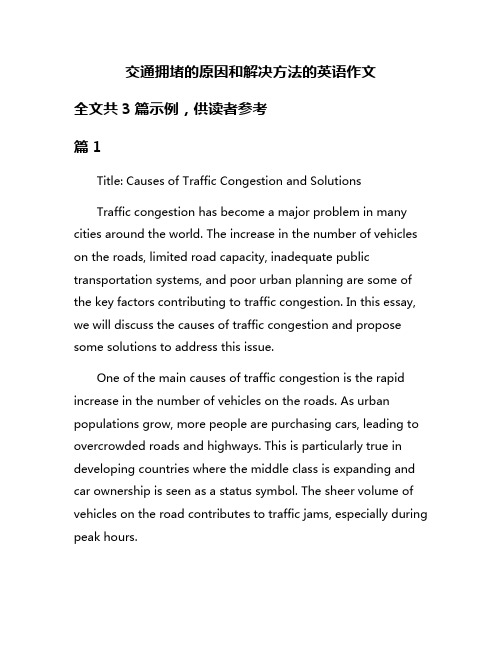
交通拥堵的原因和解决方法的英语作文全文共3篇示例,供读者参考篇1Title: Causes of Traffic Congestion and SolutionsTraffic congestion has become a major problem in many cities around the world. The increase in the number of vehicles on the roads, limited road capacity, inadequate public transportation systems, and poor urban planning are some of the key factors contributing to traffic congestion. In this essay, we will discuss the causes of traffic congestion and propose some solutions to address this issue.One of the main causes of traffic congestion is the rapid increase in the number of vehicles on the roads. As urban populations grow, more people are purchasing cars, leading to overcrowded roads and highways. This is particularly true in developing countries where the middle class is expanding and car ownership is seen as a status symbol. The sheer volume of vehicles on the road contributes to traffic jams, especially during peak hours.Another reason for traffic congestion is the limited road capacity in many cities. Urban planners have not kept up with the increasing demand for transportation infrastructure, resulting in roads that are not wide enough to accommodate the growing number of vehicles. This leads to bottlenecks and gridlock, further exacerbating the problem of traffic congestion.Inadequate public transportation systems also play a role in causing traffic congestion. Many cities lack efficient and reliable public transportation options, forcing people to rely on their cars for daily commutes. This not only adds to the number of vehicles on the road but also discourages people from using public transportation, creating a vicious cycle of congestion.Poor urban planning is another factor contributing to traffic congestion. Many cities have sprawling layouts with decentralized business districts, leading to long commutes and increased traffic congestion. Additionally, the lack of proper traffic management measures, such as traffic lights, roundabouts, and designated lanes, exacerbates congestion on the roads.To address the issue of traffic congestion, several solutions can be implemented:1. Improve public transportation systems: Cities should invest in expanding and enhancing public transportation options,such as buses, subways, and light rail systems. This will provide people with viable alternatives to driving and help reduce the number of vehicles on the roads.2. Implement congestion pricing: Charging a fee for driving in congested areas during peak hours can help reduce traffic congestion. This can incentivize people to carpool, use public transportation, or shift their travel times to off-peak hours.3. Promote sustainable modes of transportation: Encouraging cycling, walking, and car-sharing can help reduce the reliance on private cars and alleviate traffic congestion. Cities should invest in building bike lanes, pedestrian walkways, and car-sharing programs to promote these alternative modes of transportation.4. Enhance traffic management measures: Implementing intelligent transportation systems, such as traffic signal synchronization, dynamic lane control, and real-time traffic monitoring, can help improve traffic flow and reduce congestion on the roads.In conclusion, traffic congestion is a complex issue that requires a multifaceted approach to address. By understanding the causes of congestion and implementing effective solutions, cities can create a more sustainable and efficient transportationsystem for the future. By investing in public transportation, implementing congestion pricing, promoting sustainable modes of transportation, and enhancing traffic management measures, cities can alleviate traffic congestion and improve the quality of life for their residents.篇2Title: Causes of Traffic Congestion and SolutionsTraffic congestion is a major issue in cities around the world, causing frustration for commuters and leading to wasted time, fuel, and increased pollution. In this essay, we will explore the reasons behind traffic congestion and suggest possible solutions to alleviate this problem.One of the main causes of traffic congestion is an increase in the number of vehicles on the road. As populations grow and urban areas expand, more and more people are purchasing cars for their daily transportation needs. This leads to overcrowded roads and highways, making it difficult for traffic to flow smoothly.Another factor contributing to traffic congestion is the lack of efficient public transportation systems. In many cities, public transportation options are limited, unreliable, or simply notwell-developed. This forces more people to rely on their own vehicles, adding to the congestion on the roads.Furthermore, poor urban planning and infrastructure also play a role in causing traffic congestion. In some cases, roads are not designed to handle the volume of traffic they receive, leading to bottlenecks and gridlock. Additionally, construction projects, road closures, and accidents can further exacerbate traffic congestion.To address the issue of traffic congestion, several solutions can be implemented. One approach is to invest in public transportation infrastructure, such as expanding subway and bus systems, improving the frequency and reliability of services, and providing incentives for people to use public transportation.Another solution is to promote alternative modes of transportation, such as cycling and walking. By creating more bike lanes, pedestrian-friendly areas, and encouraging the use of electric scooters and other sustainable forms of transportation, cities can reduce the number of cars on the road and alleviate congestion.Additionally, implementing smart traffic management systems can help alleviate traffic congestion. By using technology to monitor traffic flow, adjust traffic signals, andprovide real-time information to drivers, cities can optimize traffic patterns and reduce congestion on the roads.In conclusion, traffic congestion is a complex issue that requires a multifaceted approach to address. By investing in public transportation, promoting alternative modes of transportation, and implementing smart traffic management systems, cities can work towards reducing traffic congestion and creating a more efficient and sustainable transportation system for all residents.篇3Title: Causes of Traffic Congestion and SolutionsThe Problem of Traffic CongestionTraffic congestion has become a major issue in both developed and developing cities around the world. It occurs when the demand for transportation exceeds the capacity of the road infrastructure, leading to slower speeds, longer travel times, and increased frustration for commuters. The causes of traffic congestion are multifaceted and vary from city to city, but some common factors include inadequate transportation infrastructure, rapid urbanization, population growth, and a reliance on private vehicles.Causes of Traffic Congestion1. Inadequate Transportation Infrastructure: Many cities have outdated or inadequate transportation infrastructure that cannot cope with the growing demand for transportation. This includes roads, bridges, tunnels, and public transportation systems that are poorly designed and maintained.2. Rapid Urbanization: As cities grow and expand, the influx of people into urban areas can overwhelm existing transportation systems. Rapid urbanization leads to increased traffic volumes and greater competition for limited road space.3. Population Growth: The increasing population in cities puts added pressure on transportation systems, as more people need to travel for work, school, and leisure activities. This results in overcrowded roads and longer travel times for commuters.4. Reliance on Private Vehicles: Many cities have a high dependency on private vehicles, leading to congestion on roads and highways. This is often due to a lack of affordable and convenient public transportation options or poor urban planning that encourages car use.Solutions to Traffic Congestion1. Improve Public Transportation: Investing in public transportation systems, such as buses, trains, and subways, can help reduce the number of private vehicles on the road. This can provide commuters with a reliable and efficient alternative to driving, easing congestion and reducing emissions.2. Expand and Upgrade Road Infrastructure: Building new roads, bridges, and highways can help increase the capacity of the transportation network and alleviate congestion. Upgrading existing infrastructure with modern technologies, such as smart traffic management systems, can also improve traffic flow and reduce delays.3. Encourage Cycling and Walking: Promoting active modes of transportation, such as cycling and walking, can help reduce the number of cars on the road and ease congestion. Providing dedicated bike lanes and pedestrian-friendly infrastructure can make these options more attractive to commuters.4. Implement Congestion Pricing: Charging drivers a fee to access certain roads or enter congested areas during peak hours can help manage traffic flow and reduce congestion. Congestion pricing can incentivize drivers to carpool, use public transportation, or travel at off-peak times.5. Encourage Telecommuting and Flexible Work Schedules: Promoting telecommuting and flexible work schedules can reduce the number of cars on the road during peak hours. This can help spread out traffic demand throughout the day and alleviate congestion on congested corridors.ConclusionAddressing the root causes of traffic congestion requires a comprehensive and multi-faceted approach that considers the unique challenges of each city. By investing in sustainable transportation infrastructure, promoting alternative modes of transportation, and implementing innovative solutions, cities can reduce congestion, improve air quality, and enhance the overall quality of urban life. It is essential for policymakers, urban planners, and transportation authorities to work together to develop effective strategies that prioritize the needs of commuters, promote environmental sustainability, and create more livable cities for future generations.。
交通拥堵解决方法英语作文

交通拥堵解决方法英语作文In the bustling city, traffic congestion has become a daily nuisance, affecting both the environment and our daily commutes. It is imperative that we explore innovative solutions to alleviate this issue.One effective approach is to improve publictransportation systems. By enhancing the efficiency and accessibility of buses, trams, and trains, we can encourage more people to leave their cars at home, thus reducing the number of vehicles on the road.Another strategy is to implement congestion pricing. This involves charging drivers a fee for entering high-traffic areas during peak hours, which can deter unnecessary car usage and encourage carpooling.Promoting the use of electric and hybrid vehicles is also crucial. These vehicles not only reduce emissions but also can be incentivized with tax breaks or subsidies, making them more attractive to consumers.Investing in smart traffic management systems can optimize traffic flow. These systems use real-time data to adjust traffic signals and provide drivers with the most efficient routes, reducing idle time and emissions.Encouraging cycling and walking is another eco-friendlyalternative. By creating safe and convenient bike lanes and pedestrian paths, we can reduce the reliance on motor vehicles for short trips.Education and awareness campaigns are also essential. Informing the public about the benefits of using public transport, carpooling, or opting for non-motorized transport can help change habits and reduce traffic congestion.Lastly, urban planning should prioritize the integration of green spaces and efficient road layouts. This not only improves the quality of life for residents but also contributes to a more organized traffic flow.By combining these strategies, we can work towards a future where traffic congestion is a problem of the past, and our cities are more livable and sustainable.。
雅思写作交通类
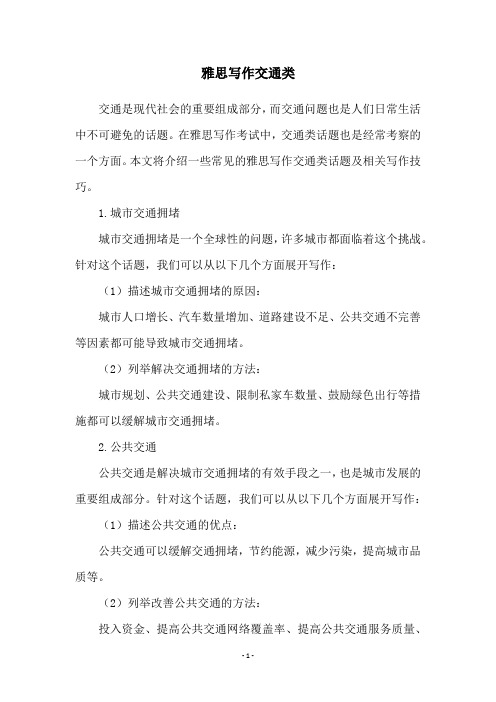
雅思写作交通类交通是现代社会的重要组成部分,而交通问题也是人们日常生活中不可避免的话题。
在雅思写作考试中,交通类话题也是经常考察的一个方面。
本文将介绍一些常见的雅思写作交通类话题及相关写作技巧。
1.城市交通拥堵城市交通拥堵是一个全球性的问题,许多城市都面临着这个挑战。
针对这个话题,我们可以从以下几个方面展开写作:(1)描述城市交通拥堵的原因:城市人口增长、汽车数量增加、道路建设不足、公共交通不完善等因素都可能导致城市交通拥堵。
(2)列举解决交通拥堵的方法:城市规划、公共交通建设、限制私家车数量、鼓励绿色出行等措施都可以缓解城市交通拥堵。
2.公共交通公共交通是解决城市交通拥堵的有效手段之一,也是城市发展的重要组成部分。
针对这个话题,我们可以从以下几个方面展开写作:(1)描述公共交通的优点:公共交通可以缓解交通拥堵,节约能源,减少污染,提高城市品质等。
(2)列举改善公共交通的方法:投入资金、提高公共交通网络覆盖率、提高公共交通服务质量、减少公共交通费用等都可以改善公共交通。
(3)探讨公共交通的未来发展:高速公路、轨道交通、自动驾驶技术等新技术的应用,将为公共交通带来更多的发展机会。
3.私家车与环境保护私家车是交通工具中的一种,但其也带来了许多环境问题。
针对这个话题,我们可以从以下几个方面展开写作:(1)私家车对环境的影响:私家车排放的废气、噪音、占用的道路面积等都对环境造成了不良影响。
(2)列举减少私家车的方法:提高燃油税、限制汽车的数量、鼓励绿色出行等都可以减少私家车的数量。
(3)探讨私家车与环境保护的平衡:私家车在现代社会中发挥了重要作用,但也需要平衡环保和交通发展之间的关系。
总之,交通类话题在雅思写作考试中是一个常见的考点。
我们需要了解交通问题的原因、解决方案以及对环境的影响等方面,以便更好地展开写作。
同时,也需要充分发挥自己的语言表达能力,使用恰当的语言、词汇和句式来表达自己的观点。
解决交通问题难的办法 英语作文带译文

解决交通问题难的办法英语作文带译文全文共3篇示例,供读者参考篇1Title: Solutions to Solve Traffic ProblemsTraffic congestion is a common issue that plagues many cities around the world. The increasing number of vehicles on the road, coupled with limited infrastructure and poor traffic management, has made commuting a frustrating experience for many people. However, there are solutions available to address these issues and improve the overall flow of traffic.One effective way to tackle traffic problems is to improve public transportation systems. Investing in reliable and efficient public transportation can encourage more people to use buses, trains, and subways instead of driving their cars. This can help reduce the number of vehicles on the road, easing congestion and reducing emissions.Another solution is to promote cycling and walking as alternative modes of transportation. Building more bike lanes and pedestrian-friendly paths can encourage people to leave their cars at home and opt for more sustainable methods oftravel. Not only does this reduce traffic congestion, but it also promotes a healthier lifestyle and reduces air pollution.Implementing smart traffic management systems can also help alleviate traffic congestion. This includes using technology such as traffic lights, cameras, and sensors to monitor traffic flow in real-time and adjust signal timings accordingly. By optimizing traffic flow and reducing delays at intersections, traffic congestion can be significantly reduced.Furthermore, implementing congestion pricing can be an effective way to manage traffic volume and reduce congestion. By charging drivers a fee to enter certain areas during peak hours, cities can discourage unnecessary trips and encourage people to carpool or use public transportation instead. This can help reduce traffic congestion and improve overall traffic flow.In conclusion, there are several solutions available to address traffic problems and improve the overall flow of traffic in cities. By investing in public transportation, promoting cycling and walking, implementing smart traffic management systems, and introducing congestion pricing, cities can work towards creating a more efficient and sustainable transportation system. It is important for governments and city planners to work together to implement these solutions and create a better environment forall commuters. Only by working together can we effectively solve the challenges of traffic congestion and create a more sustainable transportation system for the future.标题:解决交通问题的办法交通拥堵是困扰世界许多城市的常见问题。
关于解决交通拥挤的雅思作文及解析

关于解决交通拥挤的雅思作文及解析(经典版)编制人:__________________审核人:__________________审批人:__________________编制单位:__________________编制时间:____年____月____日序言下载提示:该文档是本店铺精心编制而成的,希望大家下载后,能够帮助大家解决实际问题。
文档下载后可定制修改,请根据实际需要进行调整和使用,谢谢!并且,本店铺为大家提供各种类型的经典范文,如演讲稿、总结报告、合同协议、方案大全、工作计划、学习计划、条据书信、致辞讲话、教学资料、作文大全、其他范文等等,想了解不同范文格式和写法,敬请关注!Download tips: This document is carefully compiled by this editor. I hope that after you download it, it can help you solve practical problems. The document can be customized and modified after downloading, please adjust and use it according to actual needs, thank you!In addition, this shop provides you with various types of classic sample essays, such as speech drafts, summary reports, contract agreements, project plans, work plans, study plans, letter letters, speeches, teaching materials, essays, other sample essays, etc. Want to know the format and writing of different sample essays, so stay tuned!关于解决交通拥挤的雅思作文及解析烤鸭们在生活中肯定有吐槽过城市拥挤的交通吧,大家有没有一些解决的想法呢?下面本店铺给大家带来关于解决交通拥挤的雅思作文及解析。
我们如何改善交通拥堵的建议英语作文

我们如何改善交通拥堵的建议英语作文Traffic congestion is a growing problem in many cities around the world. As the population continues to rise and more people rely on personal vehicles, the roads have become increasingly crowded, leading to longer commute times, increased pollution, and a host of other issues. However, there are several strategies that can be implemented to help alleviate traffic congestion and improve the overall flow of traffic.One of the most effective ways to address traffic congestion is to encourage the use of public transportation. By providing efficient, reliable, and affordable public transportation options, such as buses, trains, and subways, more people will be inclined to leave their cars at home and opt for a more sustainable mode of transportation. This not only reduces the number of vehicles on the road but also helps to reduce carbon emissions and improve air quality. Governments and local authorities should invest in expanding and improving public transportation infrastructure, as well as offering incentives and subsidies to encourage its use.Another strategy for reducing traffic congestion is to promote the use of carpooling and ride-sharing. By encouraging people to share rides, the number of vehicles on the road can be significantly reduced. This can be achieved through the implementation of high-occupancy vehicle (HOV) lanes, which provide dedicated lanes for vehicles with two or more passengers. Additionally, employers can offer incentives and programs to encourage their employees to carpool or use public transportation, such as providing discounted parking or subsidizing the cost of public transportation passes.Implementing congestion pricing is another effective approach to addressing traffic congestion. This involves charging a fee for vehicles entering or driving within certain areas during peak hours, which can help to discourage unnecessary driving and encourage the use of alternative modes of transportation. This strategy has been successfully implemented in cities like London, Stockholm, and Singapore, and has been shown to reduce traffic congestion and improve air quality.Another important strategy for improving traffic congestion is the use of intelligent transportation systems (ITS). These systems utilize advanced technologies, such as sensors, cameras, and data analytics, to monitor and manage traffic flow in real-time. By collecting and analyzing data on traffic patterns, ITS can help to identify bottlenecks, optimize traffic signal timing, and provide real-time information todrivers, allowing them to make informed decisions about their routes and modes of transportation.In addition to these strategies, there are also a number of infrastructure-based solutions that can be implemented to improve traffic flow. For example, the construction of additional lanes or the widening of existing roads can help to increase the capacity of the transportation network and reduce congestion. Similarly, the construction of flyovers, underpasses, and other grade-separated intersections can help to improve the flow of traffic and reduce the number of conflict points.Another important infrastructure-based solution is the development of multimodal transportation hubs, which integrate different modes of transportation, such as buses, trains, and bicycles, into a single, seamless system. By providing easy access to a variety of transportation options, these hubs can help to encourage the use of more sustainable modes of transportation and reduce the reliance on personal vehicles.Finally, it is important to consider the role of land use planning in addressing traffic congestion. By designing cities and communities that are more walkable and bikeable, and by locating residential, commercial, and employment centers in close proximity to one another, it is possible to reduce the need for long-distance travel andencourage the use of alternative modes of transportation.In conclusion, addressing traffic congestion requires a multi-faceted approach that incorporates a variety of strategies and solutions. By encouraging the use of public transportation, promoting carpooling and ride-sharing, implementing congestion pricing, utilizing intelligent transportation systems, investing in infrastructure-based solutions, and considering the role of land use planning, it is possible to improve the flow of traffic and create more sustainable and livable communities. While the specific strategies and solutions may vary depending on the unique characteristics of a particular city or region, the underlying principles of reducing the reliance on personal vehicles, promoting alternative modes of transportation, and optimizing the transportation network can be applied universally to address the challenge of traffic congestion.。
英语作文-智能交通解决方案,改善城市交通拥堵问题
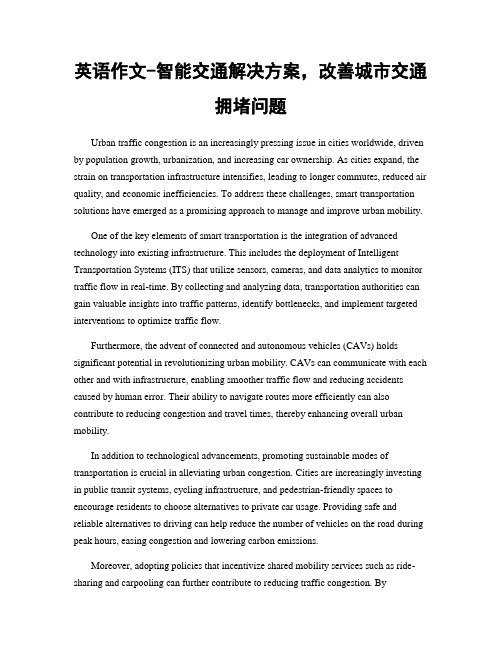
英语作文-智能交通解决方案,改善城市交通拥堵问题Urban traffic congestion is an increasingly pressing issue in cities worldwide, driven by population growth, urbanization, and increasing car ownership. As cities expand, the strain on transportation infrastructure intensifies, leading to longer commutes, reduced air quality, and economic inefficiencies. To address these challenges, smart transportation solutions have emerged as a promising approach to manage and improve urban mobility.One of the key elements of smart transportation is the integration of advanced technology into existing infrastructure. This includes the deployment of Intelligent Transportation Systems (ITS) that utilize sensors, cameras, and data analytics to monitor traffic flow in real-time. By collecting and analyzing data, transportation authorities can gain valuable insights into traffic patterns, identify bottlenecks, and implement targeted interventions to optimize traffic flow.Furthermore, the advent of connected and autonomous vehicles (CAVs) holds significant potential in revolutionizing urban mobility. CAVs can communicate with each other and with infrastructure, enabling smoother traffic flow and reducing accidents caused by human error. Their ability to navigate routes more efficiently can also contribute to reducing congestion and travel times, thereby enhancing overall urban mobility.In addition to technological advancements, promoting sustainable modes of transportation is crucial in alleviating urban congestion. Cities are increasingly investing in public transit systems, cycling infrastructure, and pedestrian-friendly spaces to encourage residents to choose alternatives to private car usage. Providing safe and reliable alternatives to driving can help reduce the number of vehicles on the road during peak hours, easing congestion and lowering carbon emissions.Moreover, adopting policies that incentivize shared mobility services such as ride-sharing and carpooling can further contribute to reducing traffic congestion. Bypromoting efficient use of vehicles and reducing the overall number of cars on the road, these initiatives can help optimize urban transportation systems and improve the qualityof life for city residents.Education and awareness play a pivotal role in shaping sustainable transportation behaviors. Informing the public about the environmental, economic, and social benefitsof using alternative modes of transportation can encourage more people to make informed choices about how they travel within cities. This cultural shift towards sustainable transportation practices is essential for achieving long-term reductions in urban congestion and promoting a healthier urban environment.Furthermore, fostering collaboration between government agencies, private sector stakeholders, and academia is essential for developing comprehensive smart transportation strategies. By leveraging each sector's strengths and resources, cities can implement integrated solutions that address the multifaceted challenges of urban congestion effectively.In conclusion, addressing urban traffic congestion requires a holistic approach that combines technological innovation, sustainable transportation solutions, policy incentives, and public engagement. By adopting smart transportation solutions and promoting sustainable mobility options, cities can mitigate congestion, improve air quality, enhance economic productivity, and create more livable urban environments for current and future generations.Through proactive planning, investment in infrastructure, and stakeholder collaboration, cities can pave the way towards a more efficient and sustainable urban transportation system. Embracing the principles of smart transportation today will lay the foundation for building smarter, more resilient cities tomorrow.。
解决道路拥堵的方案雅思作文
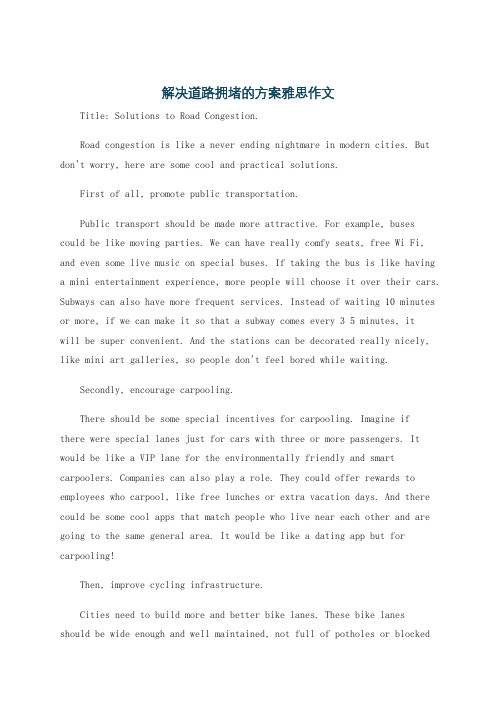
解决道路拥堵的方案雅思作文Title: Solutions to Road Congestion.Road congestion is like a never ending nightmare in modern cities. But don't worry, here are some cool and practical solutions.First of all, promote public transportation.Public transport should be made more attractive. For example, buses could be like moving parties. We can have really comfy seats, free Wi Fi, and even some live music on special buses. If taking the bus is like having a mini entertainment experience, more people will choose it over their cars. Subways can also have more frequent services. Instead of waiting 10 minutes or more, if we can make it so that a subway comes every 3 5 minutes, itwill be super convenient. And the stations can be decorated really nicely, like mini art galleries, so people don't feel bored while waiting.Secondly, encourage carpooling.There should be some special incentives for carpooling. Imagine ifthere were special lanes just for cars with three or more passengers. It would be like a VIP lane for the environmentally friendly and smart carpoolers. Companies can also play a role. They could offer rewards to employees who carpool, like free lunches or extra vacation days. And there could be some cool apps that match people who live near each other and are going to the same general area. It would be like a dating app but for carpooling!Then, improve cycling infrastructure.Cities need to build more and better bike lanes. These bike lanesshould be wide enough and well maintained, not full of potholes or blockedby parked cars. There could also be some bike sharing programs that are really user friendly. The bikes can be colorful and easy to ride. And wecan have some kind of points system. For example, every time you cycle instead of driving, you earn points that can be exchanged for things like coffee or movie tickets.Finally, manage traffic better.Traffic lights need to be smarter. They should be able to adjust according to the traffic flow. For example, if there are more cars on one side of the intersection, the light should stay green a bit longer for that side. Also, there could be some restrictions on driving in the city center during peak hours. Only essential vehicles like ambulances, buses, and delivery trucks are allowed. It might seem a bit strict, but it will really ease the congestion.In conclusion, by making public transport better, encouraging carpooling, improving cycling facilities, and managing traffic more smartly, we can start to untangle the mess of road congestion and make our cityroads more like smooth highways instead of chaotic parking lots.。
交通问题 解决方法英文作文
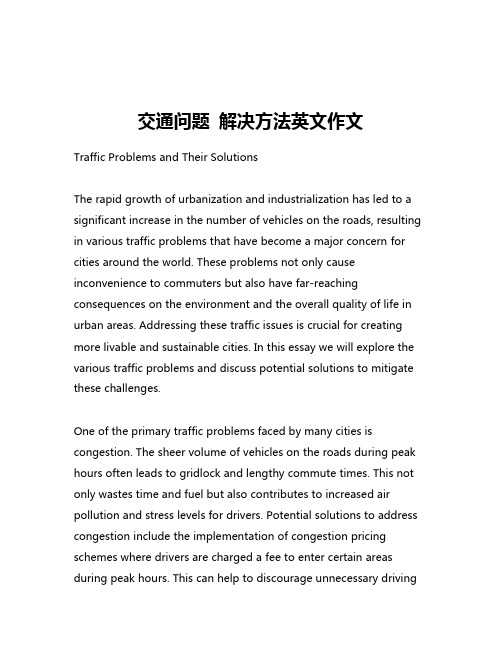
交通问题解决方法英文作文Traffic Problems and Their SolutionsThe rapid growth of urbanization and industrialization has led to a significant increase in the number of vehicles on the roads, resulting in various traffic problems that have become a major concern for cities around the world. These problems not only cause inconvenience to commuters but also have far-reaching consequences on the environment and the overall quality of life in urban areas. Addressing these traffic issues is crucial for creating more livable and sustainable cities. In this essay we will explore the various traffic problems and discuss potential solutions to mitigate these challenges.One of the primary traffic problems faced by many cities is congestion. The sheer volume of vehicles on the roads during peak hours often leads to gridlock and lengthy commute times. This not only wastes time and fuel but also contributes to increased air pollution and stress levels for drivers. Potential solutions to address congestion include the implementation of congestion pricing schemes where drivers are charged a fee to enter certain areas during peak hours. This can help to discourage unnecessary drivingand encourage the use of public transportation or carpooling. Additionally investments in public transportation infrastructure such as the expansion of bus and rail networks can provide commuters with viable alternatives to private vehicle use.Another significant traffic problem is the issue of parking. In many urban centers the demand for parking spaces often exceeds the available supply leading to a shortage of parking spots. This can result in drivers circling endlessly in search of a parking spot which further exacerbates traffic congestion. To address this problem cities can explore strategies such as the implementation of dynamic pricing for parking where rates are adjusted based on demand. This can help to ensure the availability of parking spaces and discourage long-term parking. Additionally the development of smart parking technologies that provide real-time information on parking availability can help drivers to quickly locate open spots.Traffic accidents also pose a major challenge in many cities. Factors such as reckless driving speeding and poor infrastructure can all contribute to the occurrence of accidents. Addressing this problem requires a multi-pronged approach that combines engineering solutions road safety education and enforcement of traffic laws. Implementing measures such as improving road design enhancing signage and signals and mandating the use of safety features in vehicles can help to reduce the risk of accidents. Additionallycampaigns to educate the public on safe driving practices and the strict enforcement of traffic regulations can also play a crucial role in enhancing road safety.The environmental impact of traffic is another pressing issue that needs to be addressed. The emissions from vehicles particularly in congested areas can lead to poor air quality and contribute to climate change. To mitigate these environmental concerns cities can promote the use of electric and hybrid vehicles through incentives and the expansion of charging infrastructure. Encouraging the use of public transportation cycling and walking can also help to reduce the reliance on private vehicles and lower emissions.In conclusion the traffic problems faced by cities around the world are multifaceted and require a comprehensive approach to find effective solutions. By addressing issues such as congestion parking shortages accidents and environmental impact through a combination of policy measures infrastructure investments and behavioral changes cities can work towards creating more livable and sustainable transportation systems. The successful implementation of these solutions will not only improve the quality of life for citizens but also contribute to the overall economic and social development of urban centers.。
怎样解决交通难的问题英语作文我的观点
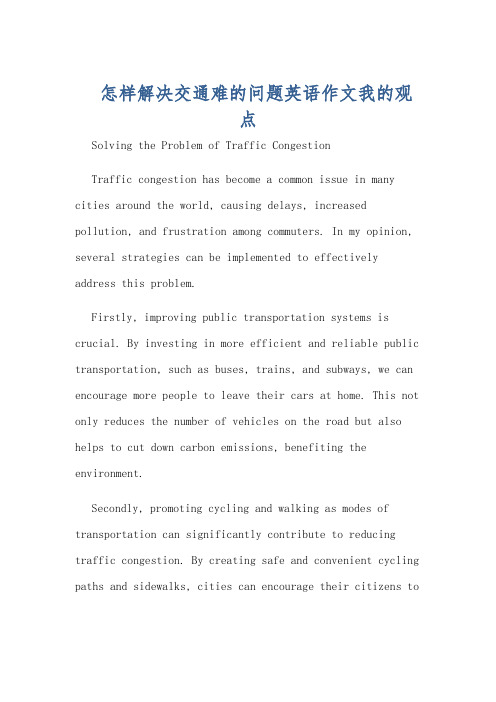
怎样解决交通难的问题英语作文我的观点Solving the Problem of Traffic CongestionTraffic congestion has become a common issue in many cities around the world, causing delays, increased pollution, and frustration among commuters. In my opinion, several strategies can be implemented to effectively address this problem.Firstly, improving public transportation systems is crucial. By investing in more efficient and reliable public transportation, such as buses, trains, and subways, we can encourage more people to leave their cars at home. This not only reduces the number of vehicles on the road but also helps to cut down carbon emissions, benefiting the environment.Secondly, promoting cycling and walking as modes of transportation can significantly contribute to reducing traffic congestion. By creating safe and convenient cycling paths and sidewalks, cities can encourage their citizens toadopt these healthier and more environmentally friendly modes of travel.Thirdly, implementing carpooling and ride-sharing programs can also help reduce the number of cars on the road. These programs allow commuters to share rides to work or other destinations, thereby reducing the overall number of vehicles and cutting down on traffic congestion.Lastly, intelligent transportation systems (ITS) can play a vital role in managing traffic flow. By utilizing real-time data and advanced technologies, ITS can help direct drivers to less congested routes, optimize traffic signals, and reduce the overall impact of traffic on the environment.In conclusion, addressing traffic congestion requires a multifaceted approach that includes improving public transportation, promoting cycling and walking, implementing carpooling and ride-sharing programs, and utilizing intelligent transportation systems. By adopting these strategies, we can effectively reduce traffic congestion, improve the quality of life for commuters, and create amore sustainable and environmentally friendlytransportation system.解决交通拥堵问题交通拥堵已成为世界各地许多城市的常见问题,给通勤者带来延误、污染增加和沮丧情绪。
高中生英语作文《城市交通拥堵的解决办法》

高中生英语作文《城市交通拥堵的解决办法》Traffic Congestion: Possible SolutionsWith the rapid development of urbanization and motorization, traffic congestion has become a major headache for city dwellers.The problem is not only time-consuming and frustrating but also has negative impacts on the environment.Therefore, it is of great importance to find effective solutions to tackle this issue.To begin with, one of the most effective ways to alleviate traffic congestion is to encourage the use of public transportation.City authorities should improve and expand public transportation systems, such as buses, subways, and light rail, to make them more convenient, reliable, and affordable.This will not only reduce the number of private vehicles on the road but also help improve air quality.Secondly, it is essential to implement strict traffic management policies.This includes enforcing traffic laws, imposing congestion charges, and introducing smart traffic signal systems.These measures will help regulate the flow of vehicles and reduce unnecessary delays.Furthermore, promoting carpooling and sharing can also contribute to easing traffic congestion.People can share rides to work or school, which will not only reduce the number of vehicles on the road but also save time and money.Additionally, the government should encourage the development of car-sharing programs, which allow people to rent cars ondemand, further reducing the need for individual ownership.Lastly, it is crucial to invest in infrastructure and urban planning that supports non-motorized transportation.This includes building more sidewalks, bike lanes, and pedestrian-friendly environments.By promoting walking and cycling, not only can we reduce traffic congestion, but we can also improve public health and reduce carbon emissions.In conclusion, solving the issue of traffic congestion requires a multi-faceted approach.By improving public transportation, implementing traffic management policies, promoting carpooling and sharing, and investing in non-motorized infrastructure, we can create more efficient, sustainable, and livable cities.It is up to governments, businesses, and individuals to work together to find lasting solutions to this pressing problem.。
怎样解决交通拥堵英语作文400词

怎样解决交通拥堵英语作文400词Title: Navigating Traffic Congestion: Finding SolutionsIntroduction:Traffic congestion has become a pressing issue in many cities worldwide. With the rapid urbanization and increasing number of vehicles on the roads, finding effective solutions to alleviate traffic congestion is imperative. This essay aims to explore several practical strategies that can help tackle this problem.1. Promoting alternative transportation options: Encouraging people to utilize alternative modes of transportation can significantly reduce traffic congestion. Investing in efficient and reliable public transportation systems, such as buses, trams, and trains, can provide attractive alternatives to driving private vehicles. Additionally, promoting cycling and walking can not only reduce vehicle congestion but also improve public health.2. Implementing carpooling systems:Introducing organized carpooling systems is an effectiveway to decrease the number of vehicles on the roads during peak hours. By sharing rides with others who have similar commutes or destinations, carpooling reduces the overall traffic volume and eases congestion. Incentives such as dedicated carpool lanes or reduced parking fees for carpoolers could further encourage participation.3. Encouraging telecommuting and flexible working hours: Advancements in technology allow individuals to work remotely from their homes or other locations rather than traveling to a central office every day. Encouraging companies to adopt telecommuting policies and offering flexible working hours can help distribute commutingpatterns throughout the day, reducing rush hour peaks and associated traffic congestion.4. Improving road infrastructure:Upgrading road infrastructure is crucial for easing traffic congestion. Constructing additional lanes on existing roads, building new roads where necessary, implementingintelligent transportation systems (ITS) that improvetraffic flow through real-time monitoring and interventions are all beneficial measures.5. Integrating smart city technologies:Innovative technologies like smart traffic lights and sensors can optimize traffic flow by adjusting signaltimings based on real-time conditions. When combined with machine learning algorithms, these technologies can predict congestion patterns and suggest alternate routes in advance, enabling drivers to make informed decisions and avoid congested areas.6. Enhancing traffic management strategies:Implementing efficient traffic management strategies isvital for reducing congestion. This includes synchronizing traffic signals, implementing strict enforcement of traffic rules, and employing trained personnel for effectivetraffic control during peak hours.Conclusion:Addressing the issue of traffic congestion requires a multifaceted approach that involves promoting alternativemodes of transportation, implementing carpooling systems, encouraging telecommuting and flexible working hours, improving road infrastructure, integrating smart city technologies, and enhancing traffic management strategies. By adopting a combination of these measures, cities can mitigate traffic congestion and create more efficient and livable urban environments for their residents.。
如何缓解交通拥堵英语作文

【导语】交通拥堵这类话题,出现在英语写作上的频率⼤家知道吗?下⾯是©⽆忧考⽹给⼤家整理的如何缓解交通拥堵英语作⽂,供⼤家参阅!【篇⼀】如何缓解交通拥堵英语作⽂ It becomes an exigent issue of the traffic control how to lead the traffic effectively, exploit the traffic resource adequately, avoid jam and reduce traffic accidents. Often, when people buy cars, they never consider the city's environmental problems, daily traffic jams, and the limited amount of parking spaces. The road designer and engineers have not designed and built the new road to solve traffic jam, but instead introduced more jam. So people begin to thrash out the way of traffic crowding and jamming, now fremdness have developed intelligent system which measure the flux of vehicle to implement traffic command. The right solution is to lay down more gallop bridges, overpasses and underpasses in big cities. The government not only needs to build more roads, but also encourage people to take public transport. You're doing your part for the environment by using public transportation, too.【篇⼆】如何缓解交通拥堵英语作⽂ Traffic congestion has long been a problem of great concern and complaint in big cities. It has caused a lot of inconvenience to people's life and work. For example, people have to set off well in advance to get to work on time and come back very late when their work is over.There are many causes for this problem, but the following may be the most important ones.The first cause is the great increase in the number of private cars. Cars take up more space but they carry fewer people. Some private car drivers, ignoring traffic regulations, drive only for the sake of their own convenience, blocking the way of other public transportation vehicles. The second cause is the slow and inefficient construction and improvement of the roads and streets. With a large population and numbers of automobiles increasing, some roads still remain unimproved, which will surely lead to problems. The last cause is the insufficient management of the traffic system and the people's lack of awareness of traffic regulations. Many pedestrians cross the streets even when the traffic lights are against them, which is an obstacle to the flow of traffic.The problem of traffic congestion is an urgent one because it concerns the safety allofus. Wewillnot resolve it if we only rely on the government. Let all of us act now to solve it.【篇三】如何缓解交通拥堵英语作⽂ How to Solve the Traffic Jam Problems. As the people's living standard increases,more and more cars crowd in families.These cars run on the roads,causing traffic jams. As we can see,the capacity of roads is limited,though they have been expanded again and again.But our cars are on the rise all the time.How can the limited roads hold the unlimited cars?As a result,traffic jams and accidents happen frequently,leading to a great economic loss,injuries,and even deaths. The situation is worse during rush hours.Every day during the rush hour time,thousands of cars in different colours can be seen,one by one lying on the roads,making a special beatutiful city scenery. It's obvious that traffic jams have become a public problem.Something has to be done. to solve it.In my opinion,first of all,cars should be restricted to go into families.Second,more money should be invested in the construction ofroads.Third,drivers are supposed to be educated to follow the traffic rules【篇四】如何缓解交通拥堵英语作⽂ As our economy grows at a fever pitch, and more and more people are moving into the major cities and industrial centers, traffic congestion BEComes the order of the day. Traffic congestion not only creates headaches for commuters, but also reduces productivity by taking away valuable time from work. This sickness that plagues our cities must be at least put under control, if not cured.Some people advocate that more roads be built to accommodate the increase in traffic, others think that enlarging the capacity of public transit systems: buses, subway, trains…is the answer. Building more roads would mean a lot of land will be appropriated—not a very good prospect for economic, agricultural, and environmental reasons. On the other hand, forcing everyone to take public transit will bring inconvenience to those whose use of their cars is essential to their work. Putting more buses on the road may have the opposite effect as big buses tend to clog up narrow streets. Building an extensive subway system can be the ideal answer, but that is very expensive. Clearly, we cannot go for one single solution. A compromise must be struck between the different solutions. My personal view is that for cities that have plenty of unused land, more roads should be built. Having special lanes reserved for bicycles and motorcycles should encourage more people to use bicycles and motorcycles instead of cars. As a long-term solution, extensive subway, or surface monorail systems should be built for all the major cities。
交通堵塞解决方案英语作文
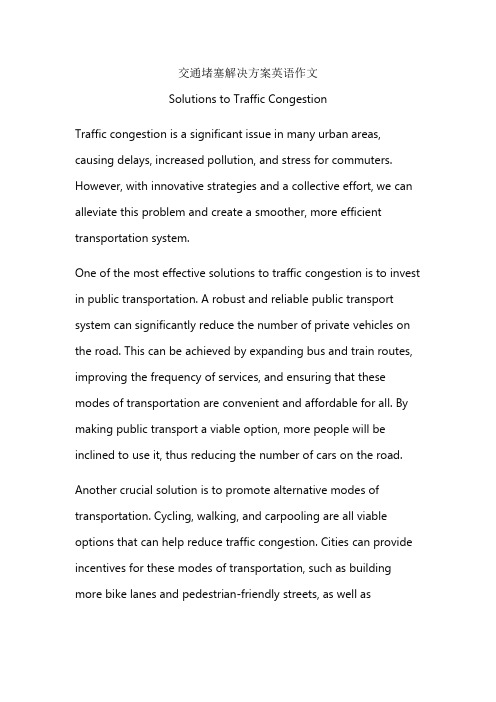
交通堵塞解决方案英语作文Solutions to Traffic CongestionTraffic congestion is a significant issue in many urban areas, causing delays, increased pollution, and stress for commuters. However, with innovative strategies and a collective effort, we can alleviate this problem and create a smoother, more efficient transportation system.One of the most effective solutions to traffic congestion is to invest in public transportation. A robust and reliable public transport system can significantly reduce the number of private vehicles on the road. This can be achieved by expanding bus and train routes, improving the frequency of services, and ensuring that these modes of transportation are convenient and affordable for all. By making public transport a viable option, more people will be inclined to use it, thus reducing the number of cars on the road. Another crucial solution is to promote alternative modes of transportation. Cycling, walking, and carpooling are all viable options that can help reduce traffic congestion. Cities can provide incentives for these modes of transportation, such as building more bike lanes and pedestrian-friendly streets, as well asproviding carpooling facilities and discounted parking for shared vehicles.Technology also plays a crucial role in alleviating traffic congestion. Advanced traffic management systems, such as real-time traffic monitoring and signal optimization, can help regulate the flow of traffic and reduce congestion. Additionally, the use of autonomous vehicles and smart traffic lights can further improve the efficiency of our transportation system.Moreover, urban planning and development should also take into account the impact of traffic congestion. Cities should encourage the development of mixed-use areas, where people can live, work, and shop within walking or cycling distance. This reduces the need for long-distance commuting and thus, traffic congestion. Finally, it is important to raise awareness about the issue of traffic congestion and its impact on the environment and society. Educating the public about the benefits of using public transport, cycling, and walking, as well as the importance of reducing car use, can help create a culture of sustainability and encourage more people to adopt these eco-friendly modes of transportation.In conclusion, traffic congestion is a complex issue that requires a multifaceted approach to address. By investing in publictransportation, promoting alternative modes of transportation, utilizing technology, improving urban planning, and raising public awareness, we can create a smoother, more efficient transportation system that benefits all.。
- 1、下载文档前请自行甄别文档内容的完整性,平台不提供额外的编辑、内容补充、找答案等附加服务。
- 2、"仅部分预览"的文档,不可在线预览部分如存在完整性等问题,可反馈申请退款(可完整预览的文档不适用该条件!)。
- 3、如文档侵犯您的权益,请联系客服反馈,我们会尽快为您处理(人工客服工作时间:9:00-18:30)。
雅思写作大作文思路交通拥堵解决办法 traffic solutions
上篇文章我们说到交通问题的原因,今天我们雅思写作大作文思路的文章来探讨下交通拥堵的解决办法。
从现实情况来看,政府已经采取了许多措施来缓解交通问题。
比如限行政策。
有些地方的限行是规定每天尾号为多少的私家车不能上路。
有些地方更加简单粗暴一些,直接就是单双号限行。
此外,大力发展公共交通也是一种解决方案,因为一辆公交车或者一班地铁的运载能力显然要比一辆私家车高太多了。
当然,也有一些地方选择修建各种快速通道和立交桥,使得穿越城市的车流可以绕过拥挤的市中心。
那么除了这些方案之外,还有那些方法可以解决交通拥堵呢?小编搜集了一些相关的素材和思路,以供大家参考。
交通拥堵解决办法 traffic solutions
In order to reduce the traffic, we should change our working habits
为了减少交通,我们应该改变自己的工作习惯。
The internet can now be used to connect people
现在,互联网可以用来联系人们。
More people could work from home
更多的人可以在家中工作
Meetings can be held as video conferences
会议可以用视频会议的方式举行。
Workers could be given flexible timetables
工人应该按照灵活的时间表工作。
Another solution would be to tax drivers
另外一个解决方案是出租车。
Workers should share their cars and travel together
上班的人应该共用他们的车辆并且一起上下班。
In London, for example, there is a congestion charge
例如,伦敦会对拥堵收费。
This helps to raise money for better public transport 这帮助为更好地公共交通筹集资金。
Public transport needs to be reliable and efficient 公共交通需要更加可靠并且有效率。
其他雅思写作交通运输类话题的思路解析。
